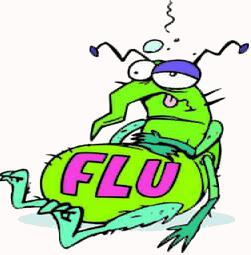Influenza Information
| Today's Flu Forecast | |
|---|---|
 |
|
|
|
Flu Map provided by Accuweather
Preventing the Flu
Clicking the links below will take you to the CDC Website
There are many actions you can take to protect yourself and others from the flu.
Influenza, commonly known as "the flu", is an infectious disease of birds and mammals caused by RNA viruses of the family Orthomyxoviridae, the influenza viruses. The most common symptoms are chills, fever, runny nose, sore throat, muscle pains, headache (often severe), coughing, weakness/fatigue and general discomfort. Although it is often confused with other influenza-like illnesses, especially the common cold, influenza is a more severe disease caused by a different type of virus.Influenza may produce nausea and vomiting, particularly in children, but these symptoms are more common in the unrelated gastroenteritis, which is sometimes inaccurately referred to as "stomach flu" or "24-hour flu".
Flu can occasionally lead to pneumonia, either direct viral pneumonia or secondary bacterial pneumonia, even for persons who are usually very healthy. In particular it is a warning sign if a child (or presumably an adult) seems to be getting better and then relapses with a high fever as this relapse may be bacterial pneumonia. Another warning sign is if the person starts to have trouble breathing.
Typically, influenza is transmitted through the air by coughs or sneezes, creating aerosols containing the virus. Influenza can also be transmitted by direct contact with bird droppings or nasal secretions, or through contact with contaminated surfaces. Airborne aerosols have been thought to cause most infections, although which means of transmission is most important is not absolutely clear. Influenza viruses can be inactivated by sunlight, disinfectants and detergents. As the virus can be inactivated by soap, frequent hand washing reduces the risk of infection.

